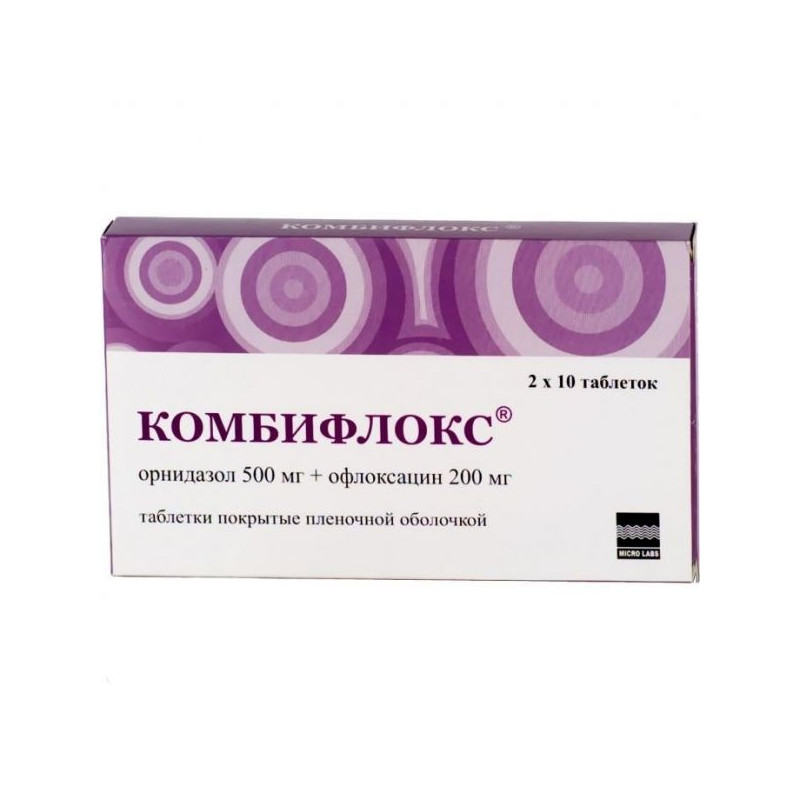



 All payments are encrypted via SSL
All payments are encrypted via SSL
 Full Refund if you haven't received your order
Full Refund if you haven't received your order
In 1 tablet, film coated, contains:
Microcrystalline cellulose 238.00 mg, sodium carboxymethyl starch 15.00 mg, croscarmellose sodium 10.00 mg, colloidal silicon dioxide 10.00 mg, talcum 9.00 mg, Magnesium stearate 12.00 mg, hypromellose 3,500 mg, opadry orange 27,000 ( hypromellose 40%, lactose monohydrate 22%, titanium dioxide 18.2%, macrogol 8.0%, triacetin 6.0%, sunset sunflower yellow (5.8%), quinoline yellow dye 0.100 mg.
In a blister pack of 10 tablets. In a cardboard bundle 2 blister packs.
Indications for use
Pharmacokinetics
Both Ofloxacin and ornidazole are well absorbed in the gastrointestinal tract after oral administration. Bioavailability - 90% (ornidazole), 95% (ofloxacin). Communication with plasma proteins - 13% (ornidazole), 25% (ofloxacin). The time to reach the maximum concentration for ofloxacin (TCmax) - 1-2 hours, for ornidazole - 3 h.
The apparent volume of distribution - 100 liters. Distribution: cells (leukocytes, alveolar macrophages), skin, soft tissues, bones, organs of the abdominal cavity and small pelvis, respiratory system, urine, saliva, bile, secret of the prostate gland. It penetrates well (BBB), the placental barrier, is secreted with mother's milk. Penetrates into the cerebrospinal fluid - 14-60%.
It penetrates into most tissues, passes through the BBB and the placenta, penetrates into breast milk.
Metabolized in the liver (about 5%) with the formation of N-oxidofloxacin and dimethylofloxacin. The half-life (T1/2) - 4.5-7 hours (regardless of dose). Excreted by the kidneys - 75-90% (unchanged), about 4% - with bile. Extrarenal clearance - less than 20%.
After a single dose of 200 mg in the urine is detected within 20-24 hours
In renal / hepatic failure, excretion may be slowed. Does not accumulate. Hemodialysis removes 10-30% of the drug.
Metabolized in the liver by hydroxylation, oxidation and glucuronidation. T1/2 - 12-14 hours. It is excreted in the form of metabolites (60-70%) and unchanged (4%) by the kidneys and intestines (20-25%), accumulates.
Combined medication, the action of which is due to the components in its composition.
Antiprotozoal and antimicrobial agent derived from 5-nitroimidazole.
The mechanism of action is the biochemical reduction of the 5-nitro group of ornidazole by the intracellular transport proteins of anaerobic bacteria and protozoa.
The restored 5-nitro group of ornidazole interacts with the DNA of microorganism cells, inhibiting the synthesis of their nucleic acids, which leads to the death of bacteria.
Active in relation to:
And also anaerobes:
Aerobic microorganisms are not sensitive to ornidazole.
Antimicrobial agent of broad-spectrum fluoroquinolone group.
It acts on the bacterial enzyme DNA gyrase, which provides superspiralipation and thus the stability of the DNA of bacteria (destabilization of the DNA chains leads to their death).
It has a bactericidal effect.
Antimicrobial spectrum includes gram-positive aerobes:
Gram-negative aerobes:
Acinetobacter calcoaceticus, Bordetel pertussis, Citrobacter freundii, Citrobacter koseri, Enterobacter aerogene Enterobacter cloacae, Escherichia coli. Haemophilus ducreyi, Haemophih influenzae, Klebsiella oxytoca, Moraxella catarrhalis, Morganella morgani Klebsiella pneumoniae, Neisseria gonorrhoeae, Proteus mirabilis, Protet vulgaris, Providencia rettgeri, Providencia stuartiras, arathropyans, arabi mirabilis;
Anaerobes:
Other:
In most cases insensitive:
Nocardia asteroide anaerobic bacteria (including Bacteroides spp., Peptococcus spp., Peptostreptococcus spp., Eubacterium spp., Fusobacterium spp., Clostridiui difficile), Enterococcus spp., Most of Streptococcus spp. 4.
Use during pregnancy and lactation
The use of the drug during pregnancy and lactation is contraindicated.
If necessary, the use of the drug during lactation should stop breastfeeding.
